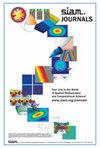里兹特征表示:用于分类任务的尺度等变散射网络
IF 2.3
3区 数学
Q3 COMPUTER SCIENCE, ARTIFICIAL INTELLIGENCE
引用次数: 0
摘要
SIAM 影像科学杂志》,第 17 卷第 2 期,第 1284-1313 页,2024 年 6 月。 摘要散射网络产生了强大而稳健的分层图像描述符,它不需要长时间的训练,只需很少的训练数据就能很好地工作。然而,它们依赖于尺度维度的采样。因此,它们对尺度变化非常敏感,无法泛化到未见过的尺度。在这项工作中,我们定义了一种基于 Riesz 变换的替代特征表示。我们详细介绍并分析了这种表示方法背后的数学基础。特别是,它继承了 Riesz 变换的尺度等差性,并完全避免了对尺度维度的采样。此外,与散射网络相比,该表示法的特征数量减少了四倍。尽管如此,我们的表示法在纹理分类方面仍有不俗的表现,而且还增加了一个有趣的功能:尺度等方差。在处理训练数据集覆盖范围之外的尺度时,我们的方法表现非常出色。我们在数字分类任务中证明了等方差特性的实用性,即使是比训练时选择的尺度大四倍的尺度,准确率也能保持稳定。第二个例子是纹理分类。最后,我们展示了如何利用这种表示来构建混合深度学习方法,这种方法比标准深度网络更能稳定地应对尺度变化。本文章由计算机程序翻译,如有差异,请以英文原文为准。
Riesz Feature Representation: Scale Equivariant Scattering Network for Classification Tasks
SIAM Journal on Imaging Sciences, Volume 17, Issue 2, Page 1284-1313, June 2024.
Abstract. Scattering networks yield powerful and robust hierarchical image descriptors which do not require lengthy training and which work well with very few training data. However, they rely on sampling the scale dimension. Hence, they become sensitive to scale variations and are unable to generalize to unseen scales. In this work, we define an alternative feature representation based on the Riesz transform. We detail and analyze the mathematical foundations behind this representation. In particular, it inherits scale equivariance from the Riesz transform and completely avoids sampling of the scale dimension. Additionally, the number of features in the representation is reduced by a factor four compared to scattering networks. Nevertheless, our representation performs comparably well for texture classification with an interesting addition: scale equivariance. Our method yields very good performance when dealing with scales outside of those covered by the training dataset. The usefulness of the equivariance property is demonstrated on the digit classification task, where accuracy remains stable even for scales four times larger than the one chosen for training. As a second example, we consider classification of textures. Finally, we show how this representation can be used to build hybrid deep learning methods that are more stable to scale variations than standard deep networks.
Abstract. Scattering networks yield powerful and robust hierarchical image descriptors which do not require lengthy training and which work well with very few training data. However, they rely on sampling the scale dimension. Hence, they become sensitive to scale variations and are unable to generalize to unseen scales. In this work, we define an alternative feature representation based on the Riesz transform. We detail and analyze the mathematical foundations behind this representation. In particular, it inherits scale equivariance from the Riesz transform and completely avoids sampling of the scale dimension. Additionally, the number of features in the representation is reduced by a factor four compared to scattering networks. Nevertheless, our representation performs comparably well for texture classification with an interesting addition: scale equivariance. Our method yields very good performance when dealing with scales outside of those covered by the training dataset. The usefulness of the equivariance property is demonstrated on the digit classification task, where accuracy remains stable even for scales four times larger than the one chosen for training. As a second example, we consider classification of textures. Finally, we show how this representation can be used to build hybrid deep learning methods that are more stable to scale variations than standard deep networks.
求助全文
通过发布文献求助,成功后即可免费获取论文全文。
去求助
来源期刊

SIAM Journal on Imaging Sciences
COMPUTER SCIENCE, ARTIFICIAL INTELLIGENCE-COMPUTER SCIENCE, SOFTWARE ENGINEERING
CiteScore
3.80
自引率
4.80%
发文量
58
审稿时长
>12 weeks
期刊介绍:
SIAM Journal on Imaging Sciences (SIIMS) covers all areas of imaging sciences, broadly interpreted. It includes image formation, image processing, image analysis, image interpretation and understanding, imaging-related machine learning, and inverse problems in imaging; leading to applications to diverse areas in science, medicine, engineering, and other fields. The journal’s scope is meant to be broad enough to include areas now organized under the terms image processing, image analysis, computer graphics, computer vision, visual machine learning, and visualization. Formal approaches, at the level of mathematics and/or computations, as well as state-of-the-art practical results, are expected from manuscripts published in SIIMS. SIIMS is mathematically and computationally based, and offers a unique forum to highlight the commonality of methodology, models, and algorithms among diverse application areas of imaging sciences. SIIMS provides a broad authoritative source for fundamental results in imaging sciences, with a unique combination of mathematics and applications.
SIIMS covers a broad range of areas, including but not limited to image formation, image processing, image analysis, computer graphics, computer vision, visualization, image understanding, pattern analysis, machine intelligence, remote sensing, geoscience, signal processing, medical and biomedical imaging, and seismic imaging. The fundamental mathematical theories addressing imaging problems covered by SIIMS include, but are not limited to, harmonic analysis, partial differential equations, differential geometry, numerical analysis, information theory, learning, optimization, statistics, and probability. Research papers that innovate both in the fundamentals and in the applications are especially welcome. SIIMS focuses on conceptually new ideas, methods, and fundamentals as applied to all aspects of imaging sciences.
 求助内容:
求助内容: 应助结果提醒方式:
应助结果提醒方式:


